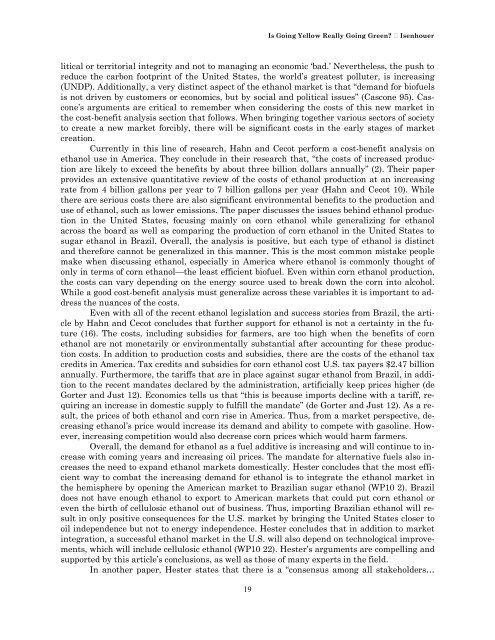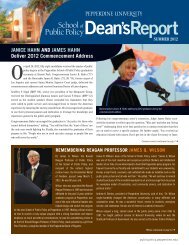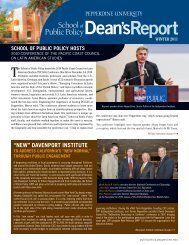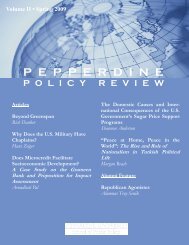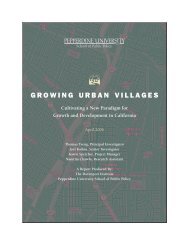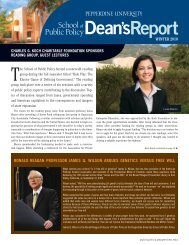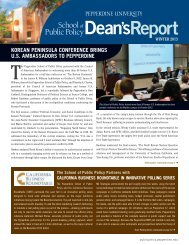Pepperdine University School of Public Policy
Pepperdine University School of Public Policy
Pepperdine University School of Public Policy
Create successful ePaper yourself
Turn your PDF publications into a flip-book with our unique Google optimized e-Paper software.
Is Going Yellow Really Going Green? Isenhouer<br />
litical or territorial integrity and not to managing an economic ‘bad.’ Nevertheless, the push to<br />
reduce the carbon footprint <strong>of</strong> the United States, the world’s greatest polluter, is increasing<br />
(UNDP). Additionally, a very distinct aspect <strong>of</strong> the ethanol market is that “demand for bi<strong>of</strong>uels<br />
is not driven by customers or economics, but by social and political issues” (Cascone 95). Cascone’s<br />
arguments are critical to remember when considering the costs <strong>of</strong> this new market in<br />
the cost-benefit analysis section that follows. When bringing together various sectors <strong>of</strong> society<br />
to create a new market forcibly, there will be significant costs in the early stages <strong>of</strong> market<br />
creation.<br />
Currently in this line <strong>of</strong> research, Hahn and Cecot perform a cost-benefit analysis on<br />
ethanol use in America. They conclude in their research that, “the costs <strong>of</strong> increased production<br />
are likely to exceed the benefits by about three billion dollars annually” (2). Their paper<br />
provides an extensive quantitative review <strong>of</strong> the costs <strong>of</strong> ethanol production at an increasing<br />
rate from 4 billion gallons per year to 7 billion gallons per year (Hahn and Cecot 10). While<br />
there are serious costs there are also significant environmental benefits to the production and<br />
use <strong>of</strong> ethanol, such as lower emissions. The paper discusses the issues behind ethanol production<br />
in the United States, focusing mainly on corn ethanol while generalizing for ethanol<br />
across the board as well as comparing the production <strong>of</strong> corn ethanol in the United States to<br />
sugar ethanol in Brazil. Overall, the analysis is positive, but each type <strong>of</strong> ethanol is distinct<br />
and therefore cannot be generalized in this manner. This is the most common mistake people<br />
make when discussing ethanol, especially in America where ethanol is commonly thought <strong>of</strong><br />
only in terms <strong>of</strong> corn ethanol—the least efficient bi<strong>of</strong>uel. Even within corn ethanol production,<br />
the costs can vary depending on the energy source used to break down the corn into alcohol.<br />
While a good cost-benefit analysis must generalize across these variables it is important to address<br />
the nuances <strong>of</strong> the costs.<br />
Even with all <strong>of</strong> the recent ethanol legislation and success stories from Brazil, the article<br />
by Hahn and Cecot concludes that further support for ethanol is not a certainty in the future<br />
(16). The costs, including subsidies for farmers, are too high when the benefits <strong>of</strong> corn<br />
ethanol are not monetarily or environmentally substantial after accounting for these production<br />
costs. In addition to production costs and subsidies, there are the costs <strong>of</strong> the ethanol tax<br />
credits in America. Tax credits and subsidies for corn ethanol cost U.S. tax payers $2.47 billion<br />
annually. Furthermore, the tariffs that are in place against sugar ethanol from Brazil, in addition<br />
to the recent mandates declared by the administration, artificially keep prices higher (de<br />
Gorter and Just 12). Economics tells us that “this is because imports decline with a tariff, requiring<br />
an increase in domestic supply to fulfill the mandate” (de Gorter and Just 12). As a result,<br />
the prices <strong>of</strong> both ethanol and corn rise in America. Thus, from a market perspective, decreasing<br />
ethanol’s price would increase its demand and ability to compete with gasoline. However,<br />
increasing competition would also decrease corn prices which would harm farmers.<br />
Overall, the demand for ethanol as a fuel additive is increasing and will continue to increase<br />
with coming years and increasing oil prices. The mandate for alternative fuels also increases<br />
the need to expand ethanol markets domestically. Hester concludes that the most efficient<br />
way to combat the increasing demand for ethanol is to integrate the ethanol market in<br />
the hemisphere by opening the American market to Brazilian sugar ethanol (WP10 2). Brazil<br />
does not have enough ethanol to export to American markets that could put corn ethanol or<br />
even the birth <strong>of</strong> cellulosic ethanol out <strong>of</strong> business. Thus, importing Brazilian ethanol will result<br />
in only positive consequences for the U.S. market by bringing the United States closer to<br />
oil independence but not to energy independence. Hester concludes that in addition to market<br />
integration, a successful ethanol market in the U.S. will also depend on technological improvements,<br />
which will include cellulosic ethanol (WP10 22). Hester’s arguments are compelling and<br />
supported by this article’s conclusions, as well as those <strong>of</strong> many experts in the field.<br />
In another paper, Hester states that there is a “consensus among all stakeholders…<br />
19


